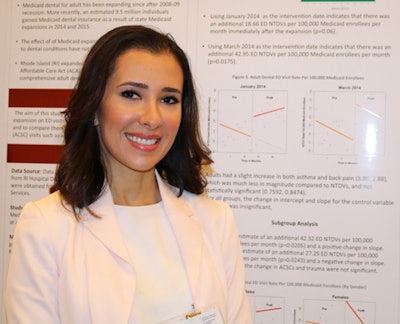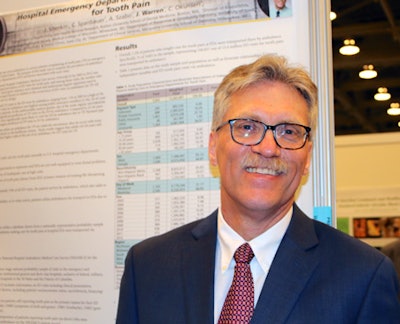
Some people take an ambulance to the hospital for tooth pain, emergency department (ED) visits seem to be increasing, and ED problems are not limited to the U.S. At least, that's according to research presented at the recent 2017 International Association for Dental Research (IADR) annual meeting in San Francisco.
During poster presentations, researchers from the U.S. and the U.K. discussed trends in emergency department use for dental conditions. They investigated everything from ambulance use to pariapical abscesses. Learn more about their findings below.
1. ED dental visits increase after Medicaid expansion
In 2014, Rhode Island expanded Medicaid, including the addition of comprehensive dental benefits. In the year after expansion, emergency departments (ED) in the state experienced an immediate and significant increase in nontraumatic dental visits, according to research presented by Eman Al Sagob, BDS, from Boston University. By comparison, ED visits for asthma and back pain declined in the same time period, although not to a significant amount.
The increase in ED visits may be due to the lack of dental providers who accept Medicaid in the state, while emergency departments do accept the insurance, Dr. Al Sagob said. It is also possible that the increase was because of pent-up demand, and nontraumatic ED use will level out over time, she added.
 Eman Al Sagob, BDS, from Boston University.
Eman Al Sagob, BDS, from Boston University.2. Periapical abscess diagnoses on the rise in ED
The number of Americans diagnosed with periapical abscesses in EDs has increased over time, according to research presented by Stacey Howes, a third-year dental student at the University of Iowa. After analyzing data from U.S. emergency departments, Howes and a colleague found that 526,000 people were diagnosed with periapical abscesses in 2013, up from 460,000 in 2008.
The vast majority of the people who were diagnosed with periapical abscesses in the emergency department were from low-income areas, and about 40% of these patients lacked insurance, according to Howes. The condition only accounts for 0.4% of all ED visits in the U.S., she noted.
 Stacey Howes from the University of Iowa.
Stacey Howes from the University of Iowa.3. U.K. patients also visit ED for dental issues
Using the emergency department for dental conditions is not strictly a U.S. problem, according to research presented by Charlotte Currie, BDS, a clinical fellow in oral surgery at Newcastle University in the U.K. Dr. Currie and colleagues found that about 1% of all people admitted to one U.K. hospital after first visiting the emergency department had a dental condition. Furthermore, 10% of those visits were from repeat patients.
Patients were typically from lower-income areas, like in the U.S., Dr. Currie said. The diagnoses were not specific, which may suggest that medical doctors feel unqualified to diagnose dental conditions, she noted.
 Charlotte Currie, BDS, from Newcastle University in the U.K.
Charlotte Currie, BDS, from Newcastle University in the U.K.4. Some patients with dental pain take ambulance to ED
People with dental problems don't just visit the emergency department, sometimes they take an ambulance there, too, according to research presented by John Warren, DDS, a professor at the University of Iowa College of Dentistry & Dental Clinics. Using data from the U.S. National Hospital Ambulatory Medical Care survey, Dr. Warren and colleagues found that about 1% of people visiting the ED with tooth pain traveled there in an ambulance. Using public insurance and being 45 to 64 years old were the strongest predictors of using an ambulance for tooth pain.
The researchers were tipped off to the trend by an emergency medical technician, Dr. Warren said. Using an ambulance for tooth pain may be putting an undue burden on the healthcare system, they noted.
 John Warren, DDS, from the University of Iowa College of Dentistry & Dental Clinics.
John Warren, DDS, from the University of Iowa College of Dentistry & Dental Clinics.


















